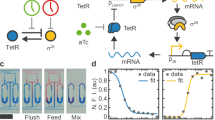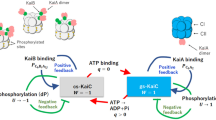Abstract
A model of coupled molecular biochemical oscillators is proposed to study non-equilibrium thermodynamics of synchronization. Under general considerations, we find that chemical interactions within an ensemble of autonomous oscillators break detailed balance and thus cost energy. This extra energy cost, in addition to the energy dissipated for driving each individual oscillator, is necessary to power the coupling interactions such as oscillator–oscillator exchange reactions, which are responsible for correcting the phase error in each individual noisy oscillator with respect to the collective oscillation of the whole ensemble. By solving the steady-state distribution of the many-oscillator system analytically and numerically, we show that the system reaches its synchronized state through a non-equilibrium phase transition as energy dissipation increases. The critical energy dissipation per period depends on both the frequency and strength of the exchange reaction, which reveals an optimal (efficient) design for achieving maximum synchronization with a fixed energy budget. We apply our general theory to the Kai system in the cyanobacterial circadian clock and predict a relationship between the KaiC ATPase activity and synchronization of the KaiC hexamers. The theoretical framework established here can be extended to study thermodynamics of collective behaviours in other non-equilibrium active systems.
This is a preview of subscription content, access via your institution
Access options
Access Nature and 54 other Nature Portfolio journals
Get Nature+, our best-value online-access subscription
$29.99 / 30 days
cancel any time
Subscribe to this journal
Receive 12 print issues and online access
$209.00 per year
only $17.42 per issue
Buy this article
- Purchase on Springer Link
- Instant access to full article PDF
Prices may be subject to local taxes which are calculated during checkout



Similar content being viewed by others
Code availability
Computer codes used in this work are available on request.
References
Pikovsky, A., Rosenblum, M. & Kurths, J. Synchronization: a Universal Concept in Nonlinear Sciences Vol. 12 (Cambridge University Press, 2003).
Strogatz, S. H. Sync: the Emerging Science of Spontaneous Order (Hyperion, 2003).
Josephson, B. Coupled superconductors. Rev. Mod. Phys. 36, 216 (1964).
Winfree, A. T. Biological rhythms and the behavior of populations of coupled oscillators. J. Theor. Biol. 16, 15–42 (1967).
Glass, L. Synchronization and rhythmic processes in physiology. Nature 410, 277–284 (2001).
Pazó, D. & Montbrió, E. Low-dimensional dynamics of populations of pulse-coupled oscillators. Phys. Rev. X 4, 011009 (2014).
Montbrió, E., Pazó, D. & Roxin, A. Macroscopic description for networks of spiking neurons. Phys. Rev. X 5, 021028 (2015).
Gregor, T., Fujimoto, K., Masaki, N. & Sawai, S. The onset of collective behavior in social amoebae. Science 328, 1021–1025 (2010).
Danino, T., Mondragón-Palomino, O., Tsimring, L. & Hasty, J. A synchronized quorum of genetic clocks. Nature 463, 326–330 (2010).
Kuramoto, Y. in International Symposium on Mathematical Problems in Theoretical Physics (ed. Araki, H.) 420–422 (Springer, 1975).
Kuramoto, Y. Chemical Oscillations, Waves and Turbulence (Springer Series in Synergetics Vol. 19, Springer, 1984).
Acebrón, J. A., Bonilla, L. L., Vicente, C. J. P., Ritort, F. & Spigler, R. The Kuramoto model: a simple paradigm for synchronization phenomena. Rev. Mod. Phys. 77, 137 (2005).
Pinto, P. D., Penna, A. L. & Oliveira, F. A. Critical behavior of noise-induced phase synchronization. Europhys. Lett. 117, 50009 (2017).
Cao, Y., Wang, H., Ouyang, Q. & Tu, Y. The free-energy cost of accurate biochemical oscillations. Nat. Phys. 11, 772–778 (2015).
Barato, A. C. & Seifert, U. Cost and precision of Brownian clocks. Phys. Rev. X 6, 041053 (2016).
Barato, A. C. & Seifert, U. Coherence of biochemical oscillations is bounded by driving force and network topology. Phys. Rev. E 95, 062409 (2017).
Gingrich, T. R. & Horowitz, J. M. Fundamental bounds on first passage time fluctuations for currents. Phys. Rev. Lett. 119, 170601 (2017).
Fei, C., Cao, Y., Ouyang, Q. & Tu, Y. Design principles for enhancing phase sensitivity and suppressing phase fluctuations simultaneously in biochemical oscillatory systems. Nat. Commun. 9, 1434 (2018).
Lee, S., Hyeon, C. & Jo, J. Thermodynamic uncertainty relation of interacting oscillators in synchrony. Phys. Rev. E 98, 032119 (2018).
Lan, G., Sartori, P., Neumann, S., Sourjik, V. & Tu, Y. The energy-speed-accuracy trade-off in sensory adaptation. Nat. Phys. 8, 422–428 (2012).
Herpich, T., Thingna, J. & Esposito, M. Collective power: minimal model for thermodynamics of nonequilibrium phase transitions. Phys. Rev. X 8, 031056 (2018).
Nguyen, B., Seifert, U. & Barato, A. C. Phase transition in thermodynamically consistent biochemical oscillators. J. Chem. Phys. 149, 045101 (2018).
Nakajima, M. et al. Reconstitution of circadian oscillation of cyanobacterial KaiC phosphorylation in vitro. Science 308, 414–415 (2005).
Rust, M. J., Markson, J. S., Lane, W. S., Fisher, D. S. & O’shea, E. K. Ordered phosphorylation governs oscillation of a three-protein circadian clock. Science 318, 809–812 (2007).
van Zon, J. S., Lubensky, D. K., Altena, P. R. & ten Wolde, P. R. An allosteric model of circadian KaiC phosphorylation. Proc. Natl Acad. Sci. USA 104, 7420–7425 (2007).
Terauchi, K. et al. ATPase activity of KaiC determines the basic timing for circadian clock of cyanobacteria. Proc. Natl Acad. Sci. USA 104, 16377–16381 (2007).
Lin, J., Chew, J., Chockanathan, U. & Rust, M. J. Mixtures of opposing phosphorylations within hexamers precisely time feedback in the cyanobacterial circadian clock. Proc. Natl Acad. Sci. USA 111, E3937–E3945 (2014).
Abe, J. et al. Atomic-scale origins of slowness in the cyanobacterial circadian clock. Science 349, 312–316 (2015).
Chang, Y.-G. et al. A protein fold switch joins the circadian oscillator to clock output in cyanobacteria. Science 349, 324–328 (2015).
Kageyama, H. et al. Cyanobacterial circadian pacemaker: Kai protein complex dynamics in the KaiC phosphorylation cycle in vitro. Mol. Cell 23, 161–171 (2006).
Emberly, E. & Wingreen, N. S. Hourglass model for a protein-based circadian oscillator. Phys. Rev. Lett. 96, 038303 (2006).
Ito, H. et al. Autonomous synchronization of the circadian KaiC phosphorylation rhythm. Nat. Struct. Mol. Biol. 14, 1084–1088 (2007).
Mori, T. et al. Elucidating the ticking of an in vitro circadian clockwork. PLoS Biol. 5, e93 (2007).
Yoda, M., Eguchi, K., Terada, T. P. & Sasai, M. Monomer-shuffling and allosteric transition in KaiC circadian oscillation. PloS ONE 2, e408 (2007).
Eguchi, K., Yoda, M., Terada, T. P. & Sasai, M. Mechanism of robust circadian oscillation of KaiC phosphorylation in vitro. Biophys. J. 95, 1773–1784 (2008).
Mori, T. et al. Circadian clock protein KaiC forms ATP-dependent hexameric rings and binds DNA. Proc. Natl Acad. Sci. USA 99, 17203–17208 (2002).
Akiyama, S. Structural and dynamic aspects of protein clocks: how can they be so slow and stable? Cell. Mol. Life Sci. 69, 2147–2160 (2012).
Prager, T., Naundorf, B. & Schimansky-Geier, L. Coupled three-state oscillators. Physica A 325, 176–185 (2003).
Wood, K., Van den Broeck, C., Kawai, R. & Lindenberg, K. Continuous and discontinuous phase transitions and partial synchronization in stochastic three-state oscillators. Phys. Rev. E 76, 041132 (2007).
Assis, V. R., Copelli, M. & Dickman, R. An infinite-period phase transition versus nucleation in a stochastic model of collective oscillations. J. Stat. Mech. Theory Exp. 2011, P09023 (2011).
Vicsek, T., Czirók, A., Ben-Jacob, E., Cohen, I. & Shochet, O. Novel type of phase transition in a system of self-driven particles. Phys. Rev. Lett. 75, 1226 (1995).
Toner, J. & Tu, Y. Flocks, herds, and schools: a quantitative theory of flocking. Phys. Rev. E 58, 4828 (1998).
Toner, J. & Tu, Y. Long-range order in a two-dimensional dynamical xy model: how birds fly together. Phys. Rev. Lett. 75, 4326 (1995).
Acknowledgements
We thank T. Theis for stimulating discussions and critical reading of the manuscript. This work is partially supported by NSFC (11434001,11774011). The work by Y.T. is partially supported by an NIH grant (R01-GM081747).
Author information
Authors and Affiliations
Contributions
D.Z. did the simulations and analysed the data; Y.C. did the simulations and analysed the data; Q.O. analysed the data; Y.T. initiated the project, developed the model, found the analytical solution and analysed the data; all wrote the paper.
Corresponding author
Ethics declarations
Competing interests
The authors declare no competing interests.
Additional information
Peer review information Nature Physics thanks Andre Cardoso Barato and the other, anonymous, reviewer(s) for their contribution to the peer review of this work.
Publisher’s note Springer Nature remains neutral with regard to jurisdictional claims in published maps and institutional affiliations.
Supplementary information
Supplementary Information
Supplementary Information.
Rights and permissions
About this article
Cite this article
Zhang, D., Cao, Y., Ouyang, Q. et al. The energy cost and optimal design for synchronization of coupled molecular oscillators. Nat. Phys. 16, 95–100 (2020). https://doi.org/10.1038/s41567-019-0701-7
Received:
Accepted:
Published:
Issue Date:
DOI: https://doi.org/10.1038/s41567-019-0701-7
This article is cited by
-
Determining subunit-subunit interaction from statistics of cryo-EM images: observation of nearest-neighbor coupling in a circadian clock protein complex
Nature Communications (2023)
-
Mechanism of autonomous synchronization of the circadian KaiABC rhythm
Scientific Reports (2021)
-
Phototunable self-oscillating system driven by a self-winding fiber actuator
Nature Communications (2021)
-
Irreversibility in dynamical phases and transitions
Nature Communications (2021)
-
Designing temporal networks that synchronize under resource constraints
Nature Communications (2021)



